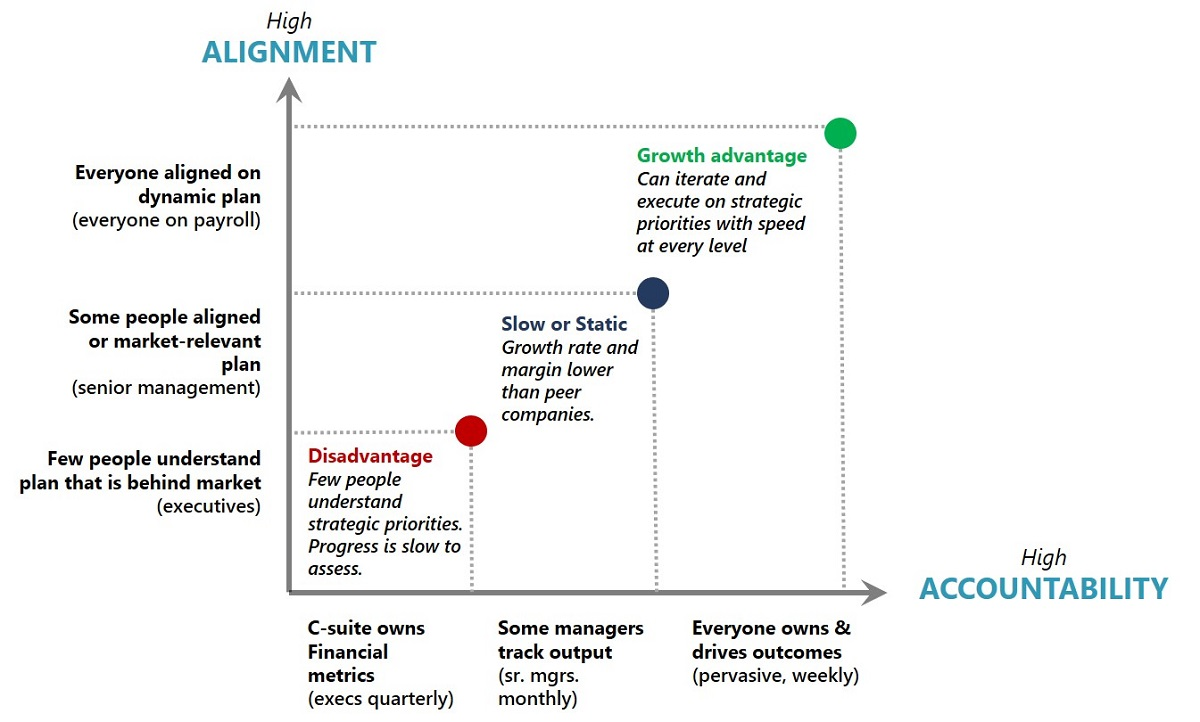Define objectives and key results
Business outcomes are how we measure strategic impact. Some organizations have existing key performance indicators (KPIs), which provide a measure for strategic impact. KPIs are a fine way to measure impact, but for organizations that don't already have operational KPIs and the rich analytics systems required to track that progress, objectives and key results (OKRs) are a more manageable approach.
This unit demonstrates how to define OKRs that can measure your strategic impact.
Define business outcomes by using OKRs
Modern operations require modern ways to measure business outcomes, and cloud technology can help increase velocity for a business. An organization's measurement platform should support a company's outcomes and plan for growth by:
- Providing insights to team members and groups.
- Supporting staff to pivot quickly when outcomes don't align with strategy and expectations.
- Offering teams a structured format, templates, sequences, and tools to help them plan for and visualize increasing velocity.
OKR overview
OKRs have proven to drive alignment in complex work environments, foster innovation, and help individuals focus on what matters. Many organizations have begun to use OKRs. OKRs are based on two components: an objective and key results for that objective. An objective is the statement of intent: what is the team trying to accomplish, and why is it important? Key results are specific outcomes that track the impact of the objective:
Objective: Clarity and intent
Key results: Measures of success within a quarter
It's important to understand that OKRs are useful for measuring team outcomes rather than individual performance. Because deadlines often motivate team performance, key results are established quarterly. OKRs help teams focus on the most important tasks instead of on the volume of work at hand. To focus on critical tasks, focus on what happens in a month, a quarter, and other short-term intervals. You can have OKRs that last longer, but shorter intervals emphasize the need for OKRs that track short-term impact.
OKR key principles
Here are the key principles of OKRs:
Aspire and inspire: Teams establish their best possible results in a given quarter, focus efforts on great outcomes, and use retrospectives to learn and iterate.
Outcome focus: Quarterly key results provide clarity on where value is created. Being aware of where value is created helps teams and the organization drive business impacts faster.
Global and local: Teams localize OKRs into their nouns, verbs, and numbers that enrich OKRs with the team's expertise and insights.
Transparent: OKRs, alignment, and progress are visible to everyone through OKR software, which simplifies collaboration and supports making good decisions faster.
How OKRs add value to an organization
OKRs help create alignment and accountability within organizations, as demonstrated in the following graph:

Examples of OKRs
The principles of OKRs can help your organization understand how useful OKRs take form. Objectives need to inspire your company and its teams to fully understand your mission. Key results need to be specific and measurable within a quarter.
Here are some examples of OKRs:
Objective 1: Be the top US provider of learning platforms to schools
Key results:
- 45 percent of K-12 schools using our platform
- A 12 percent increase in student engagement, as measured through internal systems
- A 95 percent satisfaction rate from quarterly parent surveys
Objective 2: Build a technology platform that supports every person in our business to innovate and create
Key results:
- Five new applications developed and adopted across the organization
- Every team with at least two members using Microsoft Power Platform
- Including new cloud technologies like data analytics and machine learning in all customer-facing applications
Objective 3: Transform our approach from sales driven to data driven
Key results:
- Increasing pipeline coverage from 50 percent to 200 percent
- Increasing closing rates for sales engagements by 5 percent
- Reducing the time to close deals by 8 percent
Implement OKRs
Five steps can help your organization move forward with OKRs:
Step 1: Learn. Start exploring what OKRs can do for your business. Tune in to some of your industry peers and leaders to learn how OKRs have benefited their organizations.
Step 2: Plan. As you begin to draft your OKRs, ensure that your sponsors contribute and are involved in the process. Work with an OKR coach to refine your OKRs.
Step 3: Launch. Each organization launches initiatives differently. Maintain a strong communication plan, and build the OKR calibration and celebration process into your operating model.
Step 4: Drive. To maintain rigor and focus, make sure that you're sharing outcomes and results across the organization. Sharing results and outcomes helps your teams adopt a habit of using OKRs.
Step 5: Improve. Continue to improve, revisit, and rethink how you connect across the organization. OKRs in spreadsheets can be useful, but an organization can benefit most from everyone participating to meet objectives and gain insights from the aligned data.
Record your observations
If you haven't already, download the Cloud Adoption Framework strategy and plan template. Under Business outcomes, use the OKR principles discussed in this unit to shape your first business outcomes.
Anticipate financial considerations
When migrating to the cloud, it’s important to think differently about consuming and managing your cloud resources. As you build your business case, it’s critical to understand the key principles of cloud economics and transform your mindset. Part of this transformation is discovering technical and financial flexibility, efficiencies, and capabilities that aren’t possible with your on-premises IT infrastructure. By planning short- and long-term cloud solutions and aligning them to business outcomes, you can achieve more with every dollar you invest.